How does Big Tech target children?
The Neuroscience of Child Tech Addiction (expanded) | The Waldorf Approach
Here’s what we’ll learn in this article:
1. How Big Tech execs enroll their children in low-tech schools
2. Why “immersive” education can be a code word for tech addiction
3. How does Big Tech use the playbook of Big Tobacco?
4. How wireless devices are a form of digital sorcery
5. How our primal survival instincts are hijacked by wireless tech
6. How do screens damage the brains of children and adults?
7. How much time does the average US child spend on their device?
8. What does EMF sound like to a baby’s brain?
9. How texting and playing video games retard our nervous system?
10. Will children begin to get Parkinson's in the near future?
11. How we can interrupt stress by playing with our hands
12. What does the future look like for the children of tomorrow?
13. EMF 101 Masterclass is LIVE!
To celebrate the launch of our EMF 101 Masterclass, we’re offering our beloved powerful humans a discount.
Subscribe today and get 10% off a one-year subscription & a promo code for 10% off EMF 101!
One of the many perks of working on a farm are that I get to prance around barefoot, with no shirt on, and greet customers who don’t blink an eye.
An even more valuable benefit is the connection to our local community.
Last week I did a talk at a private school, representing the farm, educating sixth graders about the true meaning of sustainability and organic.
Organic isn’t a product label - it’s a mindset of knowing where our food comes from. Sustainability isn’t a UN insect-eating agenda, it’s a lifestyle of giving back more than you put into the Earth.
While I didn’t go into politics with the children, I did explain why farming is so vital these days. Almost every child in the classroom had their hand raised, and especially loved learning about the rugged iron spade and smelling the “squid juice” I passed around.
Real sustainability doesn’t smell pretty.
What does this have to do with EMF?
"A man who carries a cat by the tail learns something he can learn in no other way."
-Mark Twain
Parents who value their childrens’ imagination, and appreciate how much potential their subconscious (theta) brain wave states hold during their formative years will enroll them into Waldorf or Montessori schools, which are notoriously low-tech.12


Steve Jobs and Bill Gates didn’t give their own children wireless devices.
Google founders Sergey Brin and Larry Page went to no-tech Montessori Schools, along with Jeff Bezos and Wikipedia founder Jimmy Wales.
Do immersion schools use iPads?
Wireless tablets are often touted as being an “immersive” form of education.
However, Big Tech execs know that education is so much more than just being stimulated by a tablet in an “immersive” (code for addictive) experience.
A true immersive experience is creating with your hands.
Michael Rich, associate professor in the Department of Society, Human Development, and Health at the Harvard School of Public Health, raised doubts about the wisdom of allowing very young children to use iPads.3
Rich questioned the iPad’s benefits as a teaching tool and suggested that, like television, it could lower children’s attention spans.
Although children enjoy iPad apps such as finger painting, Rich countered that:
“the iPad does not give you that great feeling of paint squishing through your fingers. As much of a pain as that is for parents, think how much kids are learning about cause and effect.
When children draw or paint pictures, they can make their hair all green and get a real reaction from Mom.”
The way we use our hands can develop or impair our brains, as we carry a vast array of nerve endings in our fingers, which then shape the learning and processing centers of our brains.
Recent research4 published in the journal Nature Neuroscience suggests that the nerve endings in our fingertips can perform complex neural computations that were thought to be carried out by the brain.
I find that when I use my hands on a task that doesn’t demand much cognitively, it gives my mind a chance to relax and rest. This is why I love gardening and getting my hands in dirt - it gives me a feeling of connection to the Earth that’s both primal and calming at the same time.
How are our children’s nervous systems and lives being hijacked?
From cigarette smoke to wireless radiation:
I used to be addicted to my cell phone in my twenties, and it’s nothing I miss now. Wireless devices emit blue light, which is highly-addictive as it spikes our dopamine levels5, our brain’s reward hormone. Once you’re hooked, it’s hard to get off. This addiction pathway then lets us make excuses for the radiation being “not that bad.”
Both cigarettes and radiation, also known as electrosmog, can cause cancer.6
Do you remember how cigarette ads were shown to target children? Industries such as Big Tobacco & Big Tech focus on children to boost their market share. According to a 2013 report in Bloomberg, tech companies know where to find new customers:
“if you’re looking for young people, there’s no better place to find them than in schools.” - Bloomberg (2013)
Common Core, The Bill & Melinda Gates Foundation backed initiative, was an educational flop. Nonetheless, Common Core was a boon for the tech industry, inspiring a “gold rush” to supply the iPads and laptops on which the digital curriculum was meant to be delivered.
Wireless devices were also central to Common Core’s push for “individually adaptive computerized assessment” and the collection and cloud storage of troves of “Big Brother” data on schoolchildren.
If you’d like to learn more about how Big Tech is using the same manipulative tactics as Big Tobacco, I would suggest you read the following article:
Digital Sorcery
The addiction pathways that are reinforced have even deeper implications. Dr. Peter Whybrow, director of neuroscience at UCLA, calls screens “electronic cocaine.” Chinese researchers call them “digital heroin.”
Dr. Andrew Doan, the head of addiction research for the Pentagon and the US Navy — who has been researching video game addiction — calls video games and screen technologies “digital pharmakeia” (Greek for sorcery)
In 1998, during the days of the dotcom bubble, Dr. Whybrow took over UCLA’s Institute for Neuroscience and Behavior. Since then, he has witnessed our human behavior rapidly changing, reminding him of the symptoms he observed related to clinical mania: excitement over acquiring new things, high productivity, fast speech—followed by sleep loss, irritability, and depression.
“Many of the usual constraints that prevented people from doing things 24 hours a day—like distance and darkness—were falling away.”
- Peter Whybrow
Whybrow researched why we can’t just stop this continual stimulation from the perspective of brain science.
The most primitive part of our brain - the medulla and cerebellum - developed thousands of years ago when our survival wasn’t always certain, and this brain region contains the roots of our ancient dopamine reward pathways.
When these reward circuits are overloaded with near-continuous spikes in dopamine, our craving for reward—be it drugs, sex, food, or incoming texts— “becomes a hunger that has no bounds,” says Whybrow.
Devices Hijack our Fight-Flight Response
From Manic Nation: Dr. Peter Whybrow Says We’re Addicted to Stress:
“With most natural constraints gone, all we’ve got left is our own intelligence and the internal regulatory system in the frontal cortex, the most recent evolutionary addition to the brain. This “executive brain” regulates impulse control and reasoning. But, Whybrow notes, “despite our superior intelligence, we remain driven by our ancient desires.
While our brains’ reward centers are in overdrive, so are their threat-warning systems. The brain’s hard-wired fight-or-flight response, buoyed by a rush of adrenaline, evolved as a response to acute emergencies, like fending off a charging lion.
Since the primitive “reptilian” brain can’t distinguish between a real or potential threat, it responds to any psycho-social challenge, be it rush-hour traffic, overdue mortgage payments, or repeated deadlines, by triggering some measure of the fight/flight response.
“I’ve made a conscious decision to live a life that is not driven by someone else’s priority. No matter how good that dopamine feels.”
-Peter Whybrow
Our fight / flight response is governed in large part by the stress hormone cortisol, which is spiked by blue light.7
According to the American Academy of Pediatrics, 8 to 10 year-olds spend 8 hours a day with various digital media while teenagers spend 11 hours in front of screens.
One in three kids are using tablets or smartphones before they can talk!
According to Dr. Nicholas Kardaras, once a person crosses over the line into full-blown addiction — drug, digital or otherwise — they need to detox before any other kind of therapy can have any chance of being effective. This is a full digital detox — no computers, no smartphones, no tablets.
For inspiration on a digital detox, and how to make it fun, check out
‘s plethora of resources here.How do Screens Damage our Brains?
The effects of screen addiction are not always as obvious as someone who’s had too much to drink and can’t walk straight. However, a lack of zest, of connection, often occurs as higher-level functioning and more evolved brain regions such as the neocortex are harmed.
Multiple studies have shown atrophy (shrinkage or loss of tissue volume) in gray matter areas (where “processing” occurs) in internet / gaming addiction.8
Areas affected included the important frontal lobe, which governs executive functions, such as planning, prioritizing, organizing, and impulse control.
A finding of particular concern was damage to an area known as the insula, which is involved in our capacity to develop empathy and compassion for others and our ability to integrate physical signals with emotion. Aside from the obvious link to violent behavior, these skills dictate the depth and quality of personal relationships.
The brain scan above shows Noah, who plays video games vs those of his siblings. Noah has much less activity in his normal brain state compared to his brother and sister.
What about kids who aren't "addicted" per se?
Dr. Victoria Dunckley, a Child, Adolescent & Adult Psychiatrist9 has seen a dramatic change in child behavior resulting from the use of devices:
“A much broader concern that begs awareness is the risk that screen time is creating subtle damage even in children with ‘regular’ exposure, considering that the average child clocks in more than seven hours a day.10 As a practitioner, I observe that many of the children I see suffer from sensory overload, lack of restorative sleep, and a hyper-aroused nervous system.”
Moreover, there have been many studies showing how exposure to wireless can cause DNA breaks, leading to cancers and leukemia.11
How do children absorb more RF radiaton?
Did you know that children can absorb up to ten times more radiation in the bone marrow of their skulls than adults?
“The differences in bone density and the amount of fluid in a
child’s brain compared to an adult’s brain could allow children to absorb greater quantities of RF (radiofrequency) energy deeper into their brains than adults.”-The American Academy of Pediatrics
Cell phone radiation: Child vs Adult
Children are not “little” adults.
The brain of a child contains more fluid and less fat, therefore absorbing more microwave radiation. In 1999, the Institute of Electrical and Electronics Engineers published a study12 showing how younger skulls absorb more radiation than adults. The engineers found that a child's skull is not only smaller and thinner, but matches the electromagnetic characteristics of soft tissue like the skin and brain.
Children also have:
smaller ears so a cell phone on the ear will be closer to the skull than a cell phone placed to an adult’s larger ear (which acts as a spacer between the brain and phone).
smaller heads with a shorter distance to brain centers.
an immature skull that contains more water, so the skull and adjacent tissues are more similar in a child than in an adult. This means that less radiation is reflected at the interfaces (greater reflection occurs at interfaces of less similar substances), so again, more radiation enters a child’s brain.
The following video shows how children absorb more radiation through a measurement known as SAR (specific absorption rate):
SAR measures the rate at which energy is absorbed per unit of mass by a human body when exposed to RF.
How did we get to this point?
To understand our future, we must first comprehend our primal origin.
Born on a Space Colony
Before the 1800s and the advent of the light bulb, babies born on this planet slept while being lulled to the serene, ambient sounds of nature, playing in tune with Earth’s regenerative electromagnetic pulse known as the Schumann resonance. The Schumann resonance beats in rhythm with our (alpha) brainwaves at 8 times per second (8Hz).
In today’s modern world, baby monitors emit electrical frequencies that can agitate and harm a developing brain at 2.4 billion times (2.45 Ghz) per second!
Here’s an example of what a baby monitor sounds like to the brain:
Raised on a Play Space Station
Although it’s crucial to nourish our brains, our nervous system runs through our entire body, and needs support as well. One of the most densely packed areas of nerves are our hands. The representation below, called a cortical homunculus (“little human”) is based on a neurological "map" of the areas and proportions of the human brain dedicated to processing motor and sensory functions for different parts of the body.
Note the predominance of nerve areas stemming from our hands:
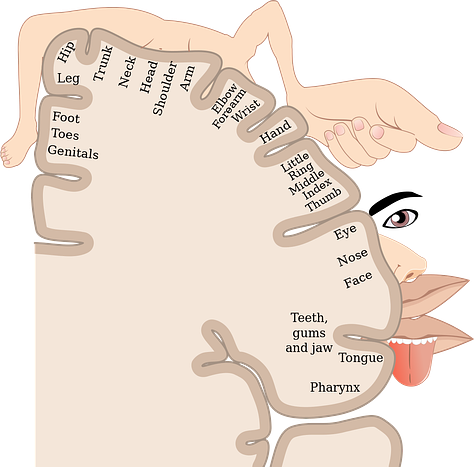
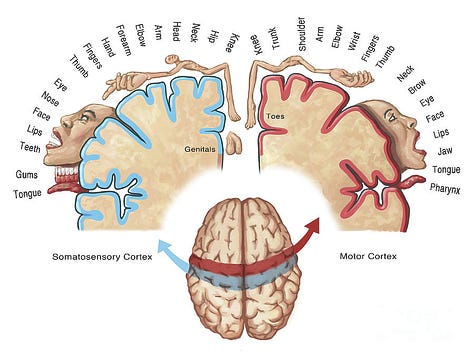

This is why it’s vital to keep ourselves engaged in cursive writing, playing musical instruments, gardening, sketching and painting as these activities stimulate both left (logical quality) and right (abstract quality) sides of our brain.
Whether it’s texting or playing on a Playstation video game controller, today’s children are mostly using their thumbs, thus disengaging most of their neural connections. Our children are becoming paler and more obese due to an increase in blue light exposure, which disrupts metabolism.13
However they’re also developing new injuries like “playstation thumb”:
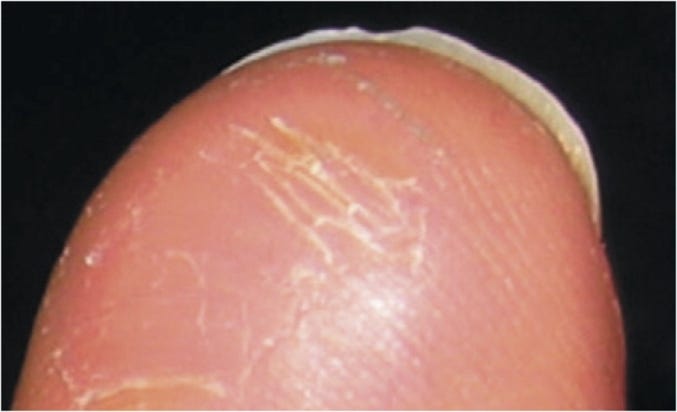
What happened to the good ole’ tobacco fingers?
I’m not a smoker, but personally I’d rather enjoy some organic tobacco over locking myself in a dark room, staring at a screen, and getting a crap sleep.
Do video games cause anxiety?
I remember being 13 years old and on the rare occasion, playing Super Mario Cart all night with my friends. All I remember is the feeling that I couldn’t stop myself. Then in my twenties, a strategy game called Civilization came along, and I would be up all night saying to myself “just one more turn.”
I realized I had a problem when my work became affected and I began to gain weight. Fortunately, I met my wife shortly thereafter and she was reason enough for me to stop.
Today’s youth play video games so much that their hands are developing inflamed and painful lumps, boils, and abscesses in or under the skin.
In a 2019 study14 by The International Journal of Pediatrics & Adolescent Medicine, researchers concluded that this swelling of the hands is caused by the “tight and continuous grasping of the hand-grips together with repeated pushing of the button” causing sweat glands to be blocked, combined with excessive palm sweat due to anxiety during the game.
Here’s how our brain perceives the electronic pulse of a Playstation controller:
Will children get Parkinson’s?
The following is an excerpt from
, from his website Out-Thinking Parkinsons , which is a treasure trove for anyone who is interested in learning how to optimize brain health:“Under chronic stress the use and senses of our hands become inhibited, as the body draws its energies inwards to protect vital organs: while we can survive the loss of a limb or two to a lion, we can't survive having our guts ripped open, so our fingers are de-prioritized from the brain and body's resources.
When unnaturally stressed too frequently or for extended time, due to the pressures of modern life for example, this loss of dexterity and proprioception (sense of relative position and effort needed to move) in our hands, and loss of senses of touch, can become permanent.
The nerve fibre connections responsible become harder to fire up as the networks of motor and sensing neurons continue to atrophy.
Indeed, the diminishing of the range of movement of the hands is one of the very first signs of PD: one of the earliest symptoms which become obvious in people developing PD manifests as handwriting getting smaller and smaller.”
How can we “interrupt” stress by playing with our hands?
Again, from Out-Thinking Parkinsons:
“The use of our hands for complex tasks is "stress interrupting", so using our hands in specific ways can be calming on the nervous system. This is especially true when using the hands for tasks which require use of other senses, such as hand-eye coordination or clapping along to music, which bring into play other parts of the brain.
Indeed, those practices which we now know can delay the progression and aid symptom reduction in people with PD all appear to involve the hands intimately:
Riding bicycles, unlike walking, involves the handle bars and the breaks, while walking with poles and sticks seems to increase the benefit of that exercise. Tai-Chi, Yoga, Qi Gong, Gyrokinetics all also focus heavily on hand shaping and on the hands leading movements. Ballet involves the expression of the hands. Then there is boxing exercise, which is proving one of the most beneficial forms for PD, which could not be more hands focused.”
How do children stay addicted to technology?
Super Mario and getting a comment from a Super model on your Instagram feed are worlds apart. We used to be the ones who could control our Gameboy, and now the social game is running us.
The Silicon Valley executives behind social media platforms like Instagram created the “swipe down” to reinforce pathways of addiction that were based on 1938 research by American psychologist B. F. Skinner at Harvard University.
Operant Conditioning, which Skinner first made reference to in 1938, is a method of learning that occurs through punishments and rewards for behaviour. We gradually condition ourselves, and associate particular behaviours, like pulling a lever on a slot machine, with its consequence: winning rewards.
This is what makes entertainment like gambling, and new forms of technology, like social media, so enticing. We want to come back to them - again and again.
Formerly a design ethicist at Google, Tristan Harris is the director and co-founder of the Center for Humane Technology as well as the co-founder of the Time Well Spent movement. Harris coined the phrase ‘human downgrading’; a term that suggests that computers are actually transforming people’s lives for the worse.
“Each time you’re swiping down, it’s like a slot machine. You don’t know what’s coming next. Sometimes it’s a beautiful photo. Sometimes it’s just an ad.”
From the article by
, Social Media and The Slot Machine:“What slot machines and social media share are variable rewards. This feeds into the ‘pull to refresh’ function. Every time we pull down to refresh our timeline—whether that’s on Facebook, Twitter or even by email—we don’t know what we’ll discover. That could be a new email from work, lots of surprising ‘likes’ or even disappointment should there be nothing fresh to excite us.
The downward-pull action, created by designer Loren Brichter, has been emulated across many different apps, and its ubiquity has become intuitive for its users. Being drawn into what’s called ‘ludic loops’—where a user is unsure whether they’ll receive feedback (or in the case of a slot machine, cash rewards) following anticipation—is what keeps us hooked. Or, as Harris says: pulling the lever.
For a sneak preview of our EMF 101 course, where we help you further understand how these addictive pathways work, and how to liberate your children from the cycle of addiction:
How can we get our children out of the digital prison?
Similar to becoming healthier through nutrition, less is often more. First, we must remove what is no longer essential, so that we can then optimally absorb the absolutely necessary.
For instance, did you know that blue light in children lowers their ability to handle UV light?
Blue light from screens destroys growth hormone, and UV light builds and regulates our hormones.
To fight inflammation, and increase UV light absorption, children need to expose themselves to early red and infrared light.
Early morning light also boosts our stores of subcellular melatonin, which even babies can receive in a mother’s Sunny womb.
A roadmap for the future: Nature & Community
Where do we go from here?
Mother Nature is trying to tell us: “Go play outside, and don’t come back until dinner’s ready!”
Playing in nature helps develop our children in three fundamental ways:
Cognitive – creativity, problem-solving, focus, and self-discipline.
Social – cooperation, flexibility, and self-awareness.
Emotional – stress reduction, reduced aggression, and increased happiness.
The following study showed how children’s abilities were improved over the course of one year when being exposed to “greenness”, or nature, trees, etc:
“We observed an enhanced progress in working memory and a greater reduction in inattentiveness associated with greenness within, and surrounding school boundaries and with total greenness surrounding home, commuting route, and school.”
-Proceedings of the National Academy of Sciences (2015)
Communities don’t build children
Children build communities. Back to that farm talk I did with the sixth graders.
I believe that children have a thirst for connection that is not just to one another, but to something greater than themselves. However, it’s not about “sharing” so everyone can get some, as I was often forced to do in my elementary school. It’s about sharing with an open heart, without pretense.
Children ultimately don’t want to share their toys, maybe not a first. What they really want to share is Self-expression of who they are.
Volunteering in a place like a community garden, or another venue, is how students can express their identity, and values15, with the plants they nourish, to the paintings they create.
“The need for imagination, a sense of truth, and a feeling of responsibility—these three forces are the very nerve of education.” - Rudolf Steiner
How do Waldorf Schools embrace community?
Here are some ways that Waldorf educators16 see the multiple benefits that students receive through social and community engagement:
Empowerment
In today’s 24/7 news cycle where children often see tragedy happening across the globe, feelings of disconnect and discouragement can become the norm. This is why it’s essential to help young people connect in meaningful and impactful ways with their community so that they see and feel firsthand how their actions have an immediate impact on the lives of others.
Skill Building
Placing real-world and relevant outcomes to actions such as problem solving, collaboration, communication, and leadership further the application of these skills in other areas. Multiple studies show that students who give back to the community perform better in school, particularly in subjects such as math, reading, and history.
Perspective
Volunteering affects a student’s worldview. Young people’s lives are often insular and their worldviews are built around themselves, their school, and their individual family environment. When working in the wider community, students have the opportunity to see how others live differently than they do, and also what others may need that they take for granted.
How many adults do you know who watch CNN 24/7 could use more volunteering?
Before we can embrace these positive steps, we must first appreciate our current situation, and step back, before we can step forward into our enduring future.
Basically: ditch our cell phone and dig a ditch with our garden trowel, together.
We are more powerful than we know.
andIf you’ve found this article valuable, would you consider sharing it?
EMF 101 has launched!
How can we measure EMFs in our environment?
How does the wiring in our homes lead to cancer?
What are some other ways we can nourish the electric field of our body?
We’ll be covering these types of specifics, along with practical steps we can take to reduce EMFs in our daily lives, and heal our relationship with technology.
Support Decentralized Medicine: Donate in Bitcoin
Send to our BTC Address!
bc1qfwtn8f95z7urkgfgj8c9t6dt3lay0shtgazr72
The new 5G meter by Safe Living Technologies is out!
Additional Resources:
Article on blue light and hormones:
Cougnard-Gregoire A, Merle BMJ, Aslam T, Seddon JM, Aknin I, Klaver CCW, Garhöfer G, Layana AG, Minnella AM, Silva R, Delcourt C. Blue Light Exposure: Ocular Hazards and Prevention-A Narrative Review. Ophthalmol Ther. 2023 Apr;12(2):755-788. doi: 10.1007/s40123-023-00675-3. Epub 2023 Feb 18. PMID: 36808601; PMCID: PMC9938358.
Höhn C, Schmid SR, Plamberger CP, Bothe K, Angerer M, Gruber G, Pletzer B, Hoedlmoser K. Preliminary Results: The Impact of Smartphone Use and Short-Wavelength Light during the Evening on Circadian Rhythm, Sleep and Alertness. Clocks Sleep. 2021 Jan 22;3(1):66-86. doi: 10.3390/clockssleep3010005. PMID: 33499010; PMCID: PMC7838958.
http://kff.org/other/poll-finding/report-generation-m2-media-in-the-lives/
C. E. Fernández-Rodríguez, A. A. A. De Salles and D. L. Davis, "Dosimetric Simulations of Brain Absorption of Mobile Phone Radiation–The Relationship Between psSAR and Age," in IEEE Access, vol. 3, pp. 2425-2430, 2015, doi: 10.1109/ACCESS.2015.2502900.
Kyriakou G, Glentis A. Skin in the game: Video-game-related cutaneous pathologies in adolescents. Int J Pediatr Adolesc Med. 2021 Jun;8(2):68-75. doi: 10.1016/j.ijpam.2019.09.002. Epub 2019 Sep 6. PMID: 34084875; PMCID: PMC8144863.










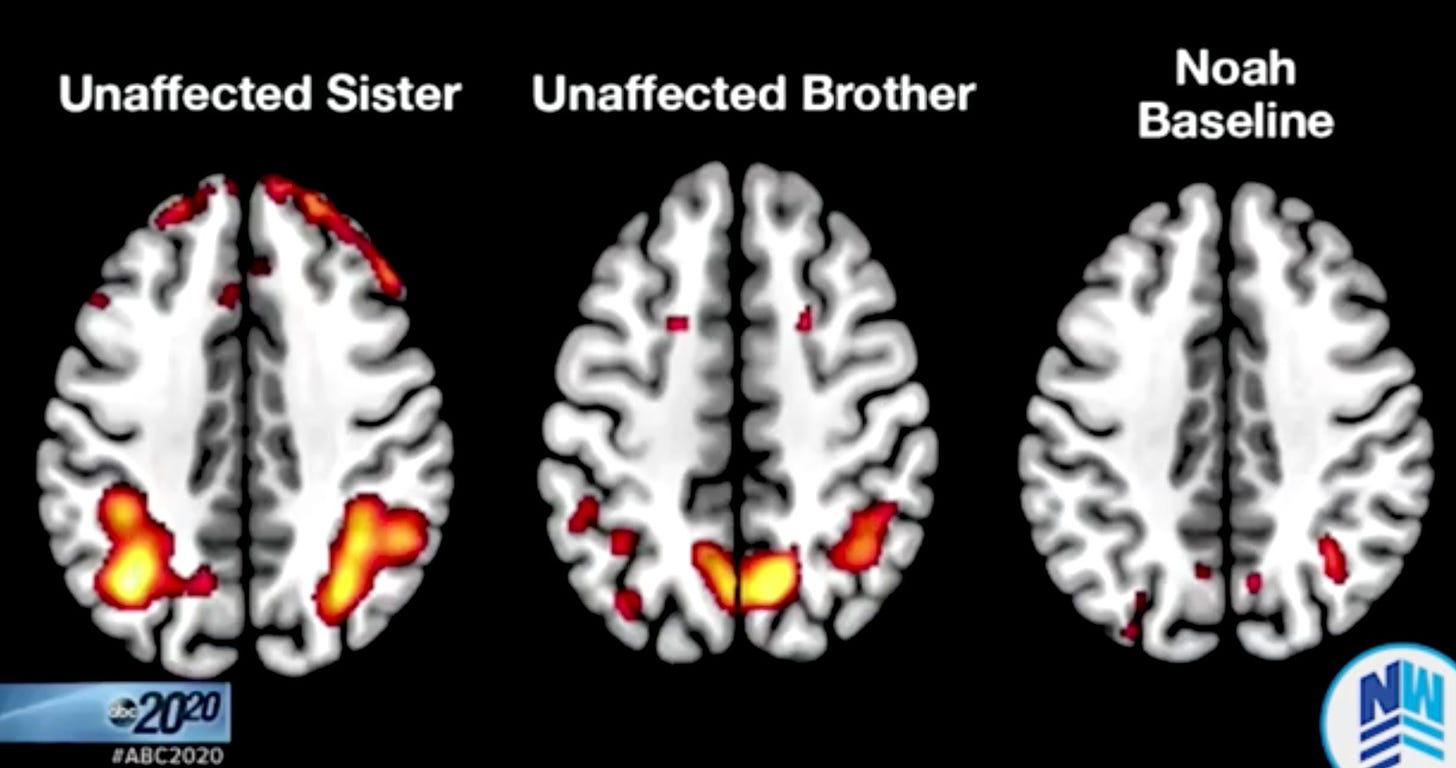
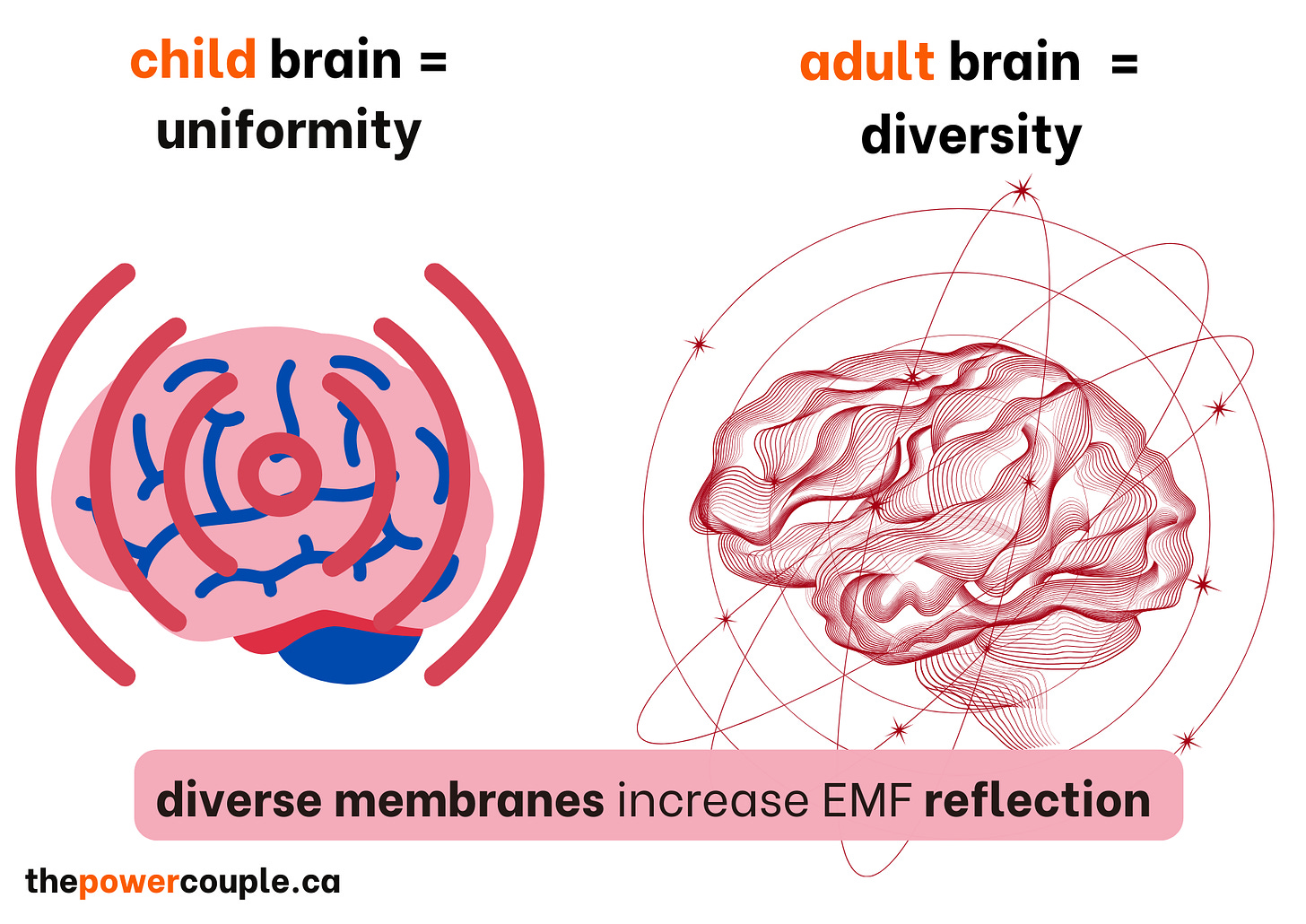

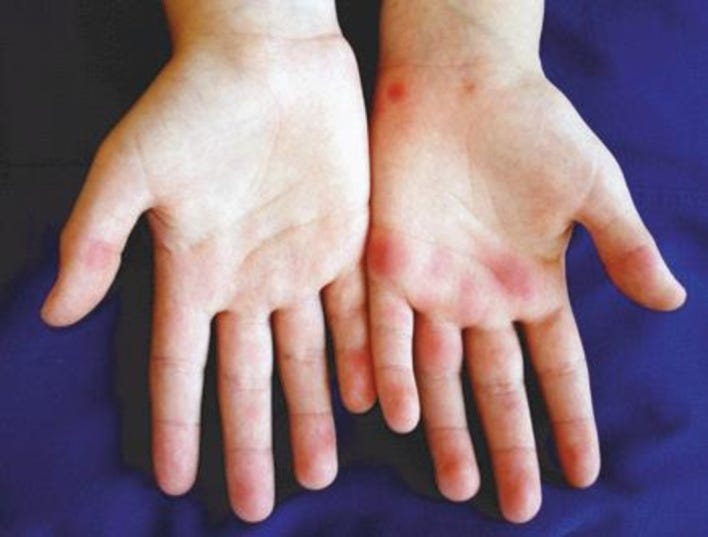

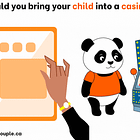





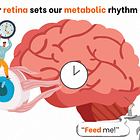
There's a cafe near my residence and each time I went in there I saw kids on ipads damaging their eyes on cognitive development.
The mention of how screens effect our empathy is a very important piece to the puzzle of a post I was thinking about writing. Thank you. People seem so much colder today that they make Mr Freeze look like a Care Bear.
The beats coming from that baby monitor were straight fire for the first few seconds. I could see someone using that in a rap song. But on a more serious note and from experience it's easy to see how gaming can make one more anxious.
Thank you important information.